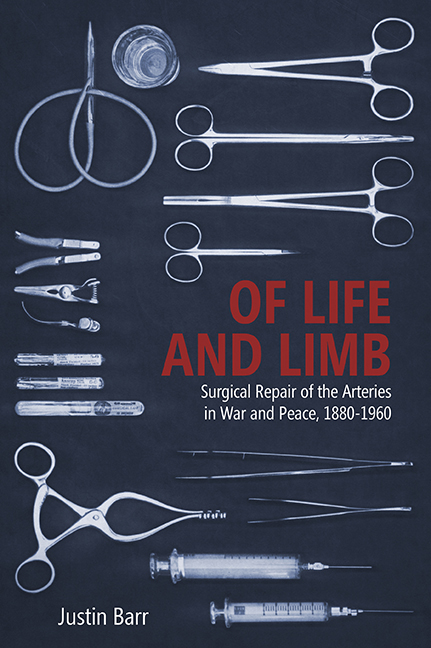 Surgical Repair of the Arteries in War and Peace, 1880–1960
Surgical Repair of the Arteries in War and Peace, 1880–1960 Book contents
- Frontmatter
- Contents
- Acknowledgments
- Introduction
- 1 Technical Change, Practical Stasis: The Development of Arterial Repair through 1914
- 2 An Ideal Rarely Practiced: Arterial Repair and Its Alternatives from World War I to World War II
- 3 Opportunities Realized and Discarded: The Management of Vascular Trauma in World War II
- 4 Reshaping Surgical Infrastructure between World War II and the Korean War
- 5 An Ideal Implemented: Arterial Repair in the Korean War
- 6 Bringing It All Back Home
- Conclusion: Arterial Repair and the Process of Surgical Change
- Notes
- Bibliography
- Index
- Frontmatter
- Contents
- Acknowledgments
- Introduction
- 1 Technical Change, Practical Stasis: The Development of Arterial Repair through 1914
- 2 An Ideal Rarely Practiced: Arterial Repair and Its Alternatives from World War I to World War II
- 3 Opportunities Realized and Discarded: The Management of Vascular Trauma in World War II
- 4 Reshaping Surgical Infrastructure between World War II and the Korean War
- 5 An Ideal Implemented: Arterial Repair in the Korean War
- 6 Bringing It All Back Home
- Conclusion: Arterial Repair and the Process of Surgical Change
- Notes
- Bibliography
- Index
Summary
Of Homer's heroes hit by spears, shot with arrows, or struck by swords in The Iliad, 90 percent died, most bleeding to death on the battlefield.1 Weapons have since grown more powerful, but the importance of saving lives and limbs remains unchanged. From Homer to the present, society has asked medical practitioners to arrest the hemorrhage and restore these individuals to their pre-injured state. As doctors have learned more about blood vessels, they have also identified nontraumatic conditions, like the aortic aneurysm that killed Albert Einstein and the clogging of vessels by cholesterol that causes heart attacks and strokes, which are also amenable to structural repair. While recent pharmaceutical interventions can ameliorate some of these conditions, throughout most of history, surgery provided the only effective therapy.
This book studies the process of how surgery changes. It focuses on operations that repair blood vessels and uses them to explore broader issues such as the relationship between theory and practice; how surgical knowledge is generated, validated, and communicated; the nature of surgical authority; the mechanisms by which a particular operation becomes standard of care; and the sociocultural conditions that promote and determine change. Written to inform both historians and surgeons, Surgical Repair of the Arteries examines how doctors took care of patients suffering from vascular trauma and disease and how that management developed over the course of the late nineteenth and twentieth centuries.
At its most fundamental level, repairing arteries restores blood flow through diseased or injured vessels. Your cells need oxygen and nutrients to survive. Blood carries these life-sustaining molecules through an interconnected web of arteries and veins called the vascular system. Arteries carry oxygen-rich, nutrient-filled blood from the heart to the periphery; veins return the depleted blood back to the core for replenishment and recirculation. From superhighways like the aorta to the tortuous back roads of microscopic capillaries, this transport network reaches every corner of the human body. Disruptions to this infrastructure can prove fatal. Trauma in the form of stabbings, shootings, and explosions can sever vessels and cause death from bleeding. Dilations of arteries called aneurysms can burst, draining the entire blood supply within minutes.
- Type
- Chapter
- Information
- Surgical Repair of the Arteries in War and Peace, 1880–1960Surgical Repair of the Arteries in War and Peace, 1880–1960, pp. 1 - 10Publisher: Boydell & BrewerPrint publication year: 2019
